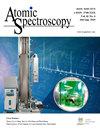200 Ng水平热电离质谱(TE-TIMS)全蒸发模式精确、质量无关的铬同位素测量
IF 2.3
2区 化学
Q1 SPECTROSCOPY
引用次数: 0
摘要
与质量无关的铬(Cr)同位素比值测量已广泛用于测定早期太阳系事件的年代和追踪不同太阳系之间的遗传关系,以及陆地物质。目前的分析技术需要相对较大的样本量,这限制了Cr同位素在宝贵的任务返回样品和一些Cr含量低的样品(例如Cr含量为~15 ppm的BCR-2)上的应用。本文报道了一种在全蒸发(TE)模式下使用热电离质谱仪(TIMS)测量与质量无关的Cr同位素比值的新分析方法。采用三步阳离子柱(AG 50W-X12树脂,200 ~ 400目)化学提纯球粒陨石、玄武岩、橄榄岩等多种样品中的Cr, Cr收率优于92%。柱状树脂中残留的有机物不利于长丝上的铬离子化,我们证明了这可以通过在加热板上用40℃的h2o2处理样品有效地去除。对铼丝的单次Cr测量消耗15至20ng的Cr,并在~10V的52 Cr下维持10至20分钟。一般来说,对于一个200 ng Cr的样品,可以进行10-15 ng的重复测量,ε 53 Cr和ε 54 Cr*的2个标准误差精度分别为~ 0.05和~ 0.10。用DTS-2b (USGS的灰岩)和NWA 7734(普通球粒陨石)进行多次测量,ε 53 Cr和ε 54 Cr的重复性(2标准偏差)分别为0.05和0.07。还进行了浓度和掺杂测试(主要是铁)。结果表明,要得到准确的ε 54 Cr, Fe/Cr必须小于5%,56 Fe/ 52 Cr必须小于1‰。最后,在TIMS上用常规方法测得的ε 53 Cr和ε 54 Cr值系统性地高于用总蒸发法测得的ε 54 Cr值,这可能是由于在TIMS上Cr蒸发和电离过程中发生的非动力学质量依赖分馏引起的。TE方法可以减少这种可能导致TIMS上不依赖质量的Cr同位素数据不准确的影响。本文章由计算机程序翻译,如有差异,请以英文原文为准。
Precise And Accurate Mass-Independent Chromium Isotope Measurement By Total Evaporation Mode On Thermal Ionization Mass Spectrometry (TE-TIMS) At 200 Ng Level
: Mass-independent chromium (Cr) isotope ratios measurements have been widely used in dating early solar system events and tracing the genetic relationships between different solar system, as well as terrestrial materials. Current analytical techniques need relatively large sample sizes, and this limits the application of Cr isotopes on precious mission return samples and some Cr-poor samples ( e.g. , BCR-2 with Cr contents of ~15 ppm). This paper reports a novel analytical method for mass-independent Cr isotopic ratios measurements using a Thermal Ionization Mass Spectrometer (TIMS) operated in total evaporation (TE) mode. A three-step cation column (AG 50W-X12 resin, 200 ~ 400 mesh) chemistry is used to purify Cr in various samples, including chondrites, basalts and peridotites, and the Cr yield is better than 92%. Residual organics from column resins is detrimental to Cr ionization on filaments, we demonstrate that this can be effectively removed by treating samples with H 2 O 2 at 40 O C on hotplate. Single Cr measurements on rhenium filaments consume 15 to 20 ng of Cr and sustain 52 Cr of ~10V for 10 to 20 minutes. Generally, for one sample of 200 ng Cr, 10-15 ng repeated measurements can be made and 2-standard error precisions of ~ 0.05 and ~ 0.10 for ε 53 Cr and ε 54 Cr*, respectively can be achieved. The reproducibility (the 2-standard deviation) for ε 53 Cr and ε 54 Cr is 0.05 and 0.07, respectively, tested by multiple measurements for DTS-2b (USGS dunite) and NWA 7734 (ordinary chondrite). Concentration and doping test (mainly for Fe) have also been conducted. These tests show that the Fe/Cr must be < 5 % and the measured 56 Fe/ 52 Cr < 1 ‰ in order to achieve accurate ε 54 Cr. Finally, the ε 53 Cr and ε 54 Cr values measured by normal method on TIMS are systematically higher than those measured by total evaporation method on TIMS, which is potentially caused by non-kinetic mass-dependent fractionation during Cr evaporation and ionization on TIMS. The TE method could reduce this effect that may cause inaccurate mass-independent Cr isotope data on TIMS.
求助全文
通过发布文献求助,成功后即可免费获取论文全文。
去求助
来源期刊

Atomic Spectroscopy
物理-光谱学
CiteScore
5.30
自引率
14.70%
发文量
42
审稿时长
4.5 months
期刊介绍:
The ATOMIC SPECTROSCOPY is a peer-reviewed international journal started in 1962 by Dr. Walter Slavin and now is published by Atomic Spectroscopy Press Limited (ASPL). It is intended for the rapid publication of both original articles and review articles in the fields of AAS, AFS, ICP-OES, ICP-MS, GD-MS, TIMS, SIMS, AMS, LIBS, XRF and related techniques. Manuscripts dealing with (i) instrumentation & fundamentals, (ii) methodology development & applications, and (iii) standard reference materials (SRMs) development can be submitted for publication.
 求助内容:
求助内容: 应助结果提醒方式:
应助结果提醒方式:


